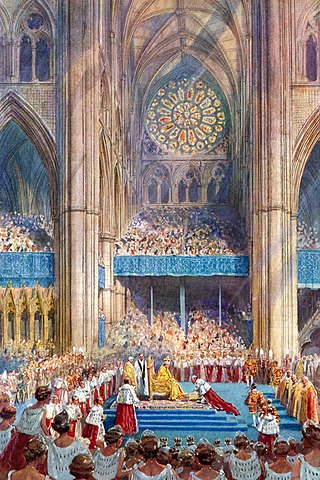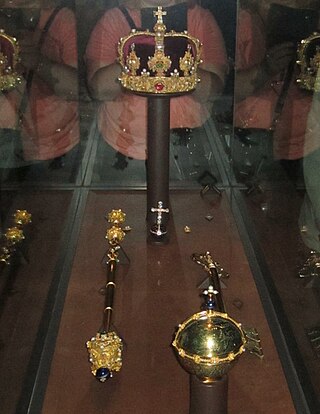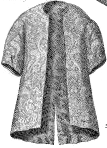
Crown jewels are the objects of metalwork and jewellery in the regalia of a current or former monarchy. They are often used for the coronation of a monarch and a few other ceremonial occasions. A monarch may often be shown wearing them in portraits, as they symbolize the power and continuity of the monarchy. Additions to them may be made, but, since medieval times, the existing items have been typically passed down unchanged, symbolizing the continuity of a monarchy.

The Crown Jewels of the United Kingdom, originally the Crown Jewels of England, are a collection of royal ceremonial objects kept in the Jewel House at the Tower of London, which include the coronation regalia and vestments worn by British monarchs.

The Imperial State Crown is one of the Crown Jewels of the United Kingdom and symbolises the sovereignty of the British monarch. It has existed in various forms since the 15th century. The 1937 version is worn by a new monarch for the first time in the royal procession following their coronation and subsequently used at State Openings of Parliament. The crown is adorned with 3,170 precious stones, including the Cullinan II diamond, St Edward's Sapphire, the Stuart Sapphire, and the Black Prince's Ruby.

The Honours of Scotland, informally known as the Scottish Crown Jewels, are the regalia that were worn by Scottish monarchs at their coronation. Kept in the Crown Room in Edinburgh Castle, they date from the 15th and 16th centuries, and are the oldest surviving set of crown jewels in the British Isles.

The coronation of the monarch of the United Kingdom is an initiation ceremony in which they are formally invested with regalia and crowned at Westminster Abbey. It corresponds to the coronations that formerly took place in other European monarchies, which have all abandoned coronations in favour of inauguration or enthronement ceremonies. A coronation is a symbolic formality and does not signify the official beginning of the monarch's reign; de jure and de facto their reign commences from the moment of the preceding monarch's death or abdication, maintaining legal continuity of the monarchy.

The colobium sindonis is a simple sleeveless white linen shift worn by British monarchs during part of the coronation service. It symbolises divesting oneself of all worldly vanity and standing bare before God. The monarch is continually robed and disrobed during the ceremony, according to ancient custom.

The Austrian Crown Jewels are the regalia and vestments worn by the Holy Roman Emperor, and later by the Emperor of Austria, during the coronation ceremony and other state functions. The term refers to the following objects: the crowns, sceptres, orbs, swords, rings, crosses, holy relics and royal robes, as well as several other objects connected with the ceremony. The collection dates from the 10th to the 19th centuries, and it reflects more than a thousand years of European history. It is kept in the Imperial Treasury at the Hofburg Palace in Vienna, Austria.

Danish Crown Regalia are the symbols of the Danish monarchy. They consist of three crowns, a sceptre, globus cruciger, the sword of state and an ampulla . The Danish Royal Regalia are kept in the treasury at Rosenborg Castle. The oldest of these is Christian III's sword of state from 1551. They further include King Christian IV's diamond; pearl- and gold-embroidered saddles; objects carved from ivory and rock-crystal; lapidary pieces of precious stones, and brooches in the form of fantastic animals.

The regalia of Norway are items that symbolise the Norwegian monarch's power and majesty. Little is known of the old Norwegian regalia which have since been lost. The majority of the modern regalia date from 1818 and were made for the coronation of Jean Bernadotte as King Carl III Johan.

Sweden's regalia are kept deep in the vaults of the Royal Treasury, underneath the Royal Palace in Stockholm, in a museum that is open to the public. The crowns and coronets have not been worn by Swedish royalty since 1907, but they are still displayed at weddings, christenings and funerals.

The Holy Roman Emperor received the imperial regalia from the hands of the Pope, symbolizing both the pope's right to crown Christian sovereigns and also the emperor's role as protector of the Catholic Church. The Holy Roman empresses were crowned as well.

Coronations were previously held in the monarchies of Europe. The United Kingdom is the only monarchy in Europe that still practises coronation. Other European monarchies have either replaced coronations with simpler ceremonies to mark an accession or have never practised coronations. Most monarchies today only require a simple oath to be taken in the presence of the country's legislature.

The Portuguese crown jewels, also known as the Royal Treasure, are the pieces of jewelry, regalia, and vestments that were used by the Kings and Queens of Portugal during the time of the Portuguese Monarchy. Over the nine centuries of Portuguese history, the Portuguese crown jewels have lost and gained many pieces. Most of the current set of the Portuguese crown jewels are from the reigns of King João VI and King Luís I.

The coronation of George VI and his wife, Elizabeth, as king and queen of the United Kingdom and the Dominions of the British Commonwealth, Emperor and Empress consort of India took place at Westminster Abbey, London, on Wednesday 12 May 1937. George VI ascended the throne upon the abdication of his brother, Edward VIII, on 11 December 1936, three days before his 41st birthday. Edward's coronation had been planned for 12 May and it was decided to continue with his brother and sister-in-law's coronation on the same date.

The coronation of the Danish monarch was a religious ceremony in which the accession of the Danish monarch was marked by a coronation ceremony. It was held in various forms from 1170 to 1840, mostly in Lund Cathedral in Lund, St. Mary's Cathedral in Copenhagen and in the chapel of Frederiksborg Palace in Hillerød.

Coronations of the Swedish monarchs took place in various cities during the 13th and 14th centuries, but from the middle of the 15th century onward in the cathedrals of Uppsala or Stockholm, with the exception of the coronation of Gustav IV Adolf, which took place in Norrköping in 1800. Earlier coronations were also held at Uppsala, the ecclesiastical center of Sweden. Prior to Sweden's change to a hereditary monarchy, the focus of the coronation rite was on legitimising an elected king.

The Robe of State is a robe worn by the British monarch on state occasions. A monarch typically has a robe made for their coronation and reuses it when attending the State Opening of Parliament at the start of each legislative session. Traditionally the robes have an ermine cape with a long train made of crimson coloured velvet, trimmed in gold lace and lined with ermine.

A Supertunica is a robe worn by a British monarch at their coronation. It is donned shortly after the Anointing ceremony for the vesting of the Spurs, Sword of Offering and the Armills. Afterwards the Stole Royal and Robe Royal are worn on top of the Supertunica for the crowning of the monarch. The Supertunica, Stole and Robe are replaced with the Imperial Robe for the final procession from Westminster Abbey.

The Stole Royal is an item of regalia used during the coronation of a British monarch, similar to the stoles worn as vestments by clergymen. It is donned after the anointing of the monarch and is worn throughout the crowning, receiving of homage and conclusion of the communion. The Stole Royal is removed, with other garments, before the procession from Westminster Abbey for which the Imperial Robe is worn.

The Imperial Robe is a robe used in the Coronation of the British monarch. It is donned in the final stages of the ceremony for the procession of the monarch from Westminster Abbey to the waiting Gold State Coach. These Robes were last seen at the Coronation of Charles III and Camilla, with King Charles III wearing the Imperial Robe of George VI, and Queen Camilla having a new robe made for her.



















